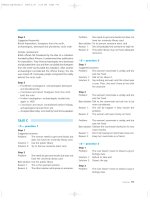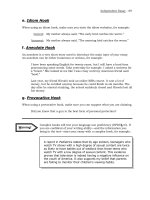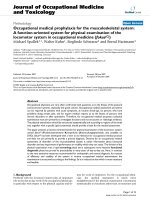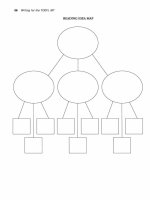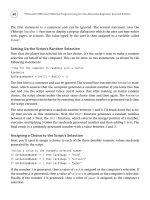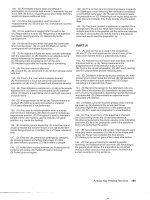Clinical Tests for the Musculoskeletal System - part 9 ppsx
Bạn đang xem bản rút gọn của tài liệu. Xem và tải ngay bản đầy đủ của tài liệu tại đây (827.6 KB, 31 trang )
Posterior Droop Test
Procedure:
Both knees are held parallel in 90° of flexion.
Assessment:
Inspecting the silhouettes of both tibial heads from the
side reveals that the tibial head in the affected knee appears to “droop.”
The rest position of the posterior drawer is influenced by gravity and is a
sensitive sign of a posterior cruciate ligament injury.
Soft Posterolateral Drawer Test
Procedure:
The patient is seated with the legs r elaxed and hanging
over the edge of the table. The foot of the affected leg rests lightly on the
thigh of the examiner, who crouches in front of the patient. The e xam-
iner grasps the tibial head with both hands and presses it posteriorly
with the balls of the thumbs.
Assessment:
Posterior translation (drawer motion) of the lateral tibial
plateau is a sign of posterolateral instability.
Knee 219
Fig.
229
Posterior droop test
Fig.
230
Soft posterolateral drawer test
Buckup, Clinical Tests for the Musculoskeletal System © 2004 Thieme
All rights reserved. Usage subject to terms and conditions of license.
Gravity Sign and Genu Recurvatum Test
Procedure:
The patient is supine with the hip and knee of the affected
leg flexed 90°. With one hand, the examiner grasps the patient’s lower
leg while stabilizing the knee proximal to the patella with the other
hand. The examiner then abruptly pulls away the stabilizing hand from
the knee.
Assessment:
If the posterior cruciate ligament is torn, the tibia will
recede posteriorly (posterior droop).
220 Knee
a
b
Fig.
231a, b
Gravity sign and genu recurvatum test:
a
stabilizing the joint,
b
posterior droop of the tibia after removal of stabilization
Buckup, Clinical Tests for the Musculoskeletal System © 2004 Thieme
All rights reserved. Usage subject to terms and conditions of license.
Note:
In the genu recurvatum test, the extended leg is lifted. A torn
posterior cruciate ligament will result in a posterior droop of the
tibia.
Hughston Test for Genu Recurvatum and External Rotation
Procedure:
The patient is supine with both quadriceps completely
relaxed. The examiner then lifts each forefoot.
Assessment:
In posterolateral instability, this maneuver will produce a
hyperextended varus position in the knee with simultaneous external
rotation of the tibia.
Note:
To demonstrate the external rotation and genu recurvatum
deformity (hyperextension) more clearly, the test may be performed
on one leg at a time. This is done by moving th e knee from slight flexion
into extension. The examiner places one hand on the posterior aspect of
the knee to palpate the posterior droop and the slight e x te rn al rotation
of the proximal tibia.
Knee 221
a b
Fig.
232a, b
Hughston test for genu recurvatum and external rotation:
a
hyperextended varus position,
b
flexion into extension movement
Buckup, Clinical Tests for the Musculoskeletal System © 2004 Thieme
All rights reserved. Usage subject to terms and conditions of license.
Godfrey Test
Procedure:
The patient is supine with both knees and hips flexed 90°.
The examiner holds the patient’s l ower legs w hile pressing the tibial
tuberosity of the injured knee posteriorly.
Assessment:
Even in the starting position, the examiner will readily
notice the slight posterior droop in the proximal tibia indicative of
posterior cruciate ligament insuf• ciency. Applying pressure to the an-
terior tibia increases the posterior droop of the lateral tibial plateau.
222 Knee
a
b
Fig.
233a, b
Godfrey test:
a
slight posterior droop of the tibia.
b
Pressing increases the droop
Buckup, Clinical Tests for the Musculoskeletal System © 2004 Thieme
All rights reserved. Usage subject to terms and conditions of license.
Dynamic Posterior Shift Test
Procedure:
The patient is supine. The examiner passively flexes the hip
and knee of the affected leg 90°, holding the knee in neutral rotation.
One of the examiner’s hands rests on th e thigh and acts as a buttress
while the examiner slowly extends the knee with the other hand.
Assessment:
Once the knee reaches about 20° of flexion, the examiner
will be able to observe and palpate an abrupt movement of the tibial
plateau out of posterior subluxation into reduction and external rota-
tion.
Knee 223
a b
Fig.
234a, b
Dynamic posterior shift test:
a
subluxation with hip and knee flexed 90°,
b
reduction as the knee approaches extension
Buckup, Clinical Tests for the Musculoskeletal System © 2004 Thieme
All rights reserved. Usage subject to terms and conditions of license.
Foot
Almost all patients presenting with foot problems have pain. For this
reason, a precise history is very important in diagnosing the disorder.
Age, gender, occupation, and leisure activities are important factors
to consider in every patient. It is important to enquire about the char-
acter of the onset of pain, its location and radiation, its nature, and about
factors that can cause pain. Both feet and the adjacent joints such as the
knee should be examined and assessed comparatively. Axial deviations
in the legs should also be given consideration. Inspection of the shape
and soles of the patient’s shoes is important as asymmetric we ar on the
soles may provide an initial indication of the cause of the patient’s
complaints.
In addition to a palpatory examination with assessment of mobility
and tenderness to pa lpation in the specific region, it is important to
observe the foot during weight bearing and walking. Metatarsalgia is a
general term for pain in the forefoot. Splay foot is the most common
deformity of the foot and the most com mon cause o f metatarsalgia. The
collapse of the transverse metatarsal arch as a result of weakness of the
muscles and ligaments leads to secondary changes in the foot with claw
toe and hammer toe deformities and hallux valgus. Plantar calluses from
the increased stresses on the metatarsal heads in turn lead to additional
problems.
Other causes of forefoot pain include osteoarthritis (hallux rigidus),
neuromas (Morton neuroma), stress fractures, avascular ne crosis (Koeh-
ler disease), disorders of the sesamoids, plantar warts, and compression
neuropathies (tarsal tunnel syndrome).
Certain systemic diseases tend to involve the foot. Often the first
clinical symptoms of these disorders will appear in the foot. Such dis-
orders include diabetes mellitus, peripheral arterial disease, gout, psor-
iasis, collagen disorders, and rheumatoid arthritis.
Buckup, Clinical Tests for the Musculoskeletal System © 2004 Thieme
All rights reserved. Usage subject to terms and conditions of license.
˾
Range of Motion in the Ankle and Foot
(Neutral-Zero Method)
Foot 225
a b
c d e
Fig.
235a, b
Plantar flexion and dor-
siflexion of the foot when standing:
plantar flexion (
a
), dorsiflexion (
b
)
f
g h i
j
k
l
c, d
Pronation (
c
) and supination (
d
) of th e forefoot.
One hand grasps the heel and the other turns the forefoot. Only the angle
of the forefoot relative to the hindfoot is measured as pronation and
supination
e, f
Eversion (
e
) and inversion (
f
) of the hindfoot.
Onehandgraspsthelowerlegandtheothergraspstheposterioraspectofthe
forefoot, holding the calcaneus between thumb and forefinger (not shown).
The inversion and eversion is evaluated on the calcaneus (axis of the cal-
caneus, A). Care should be taken to avoid pronation or supination of the foot
g
Plantar flexion and dorsiflexion of the ankle (talocrural joint) with the foot
hanging relaxed
h–l
Motion in the metatarsophalangeal joints: great toe (
h, i
), other toes (
j–l
)
Buckup, Clinical Tests for the Musculoskeletal System © 2004 Thieme
All rights reserved. Usage subject to terms and conditions of license.
226 Foot
m n o
p q r
s
t u
v
Fig.
235
m–o
The most common variations in forefoot and toe length:
Greek (
m
), square (
n
), and Egyptian as described by Lelièvre (
o
)
p–r
Assessment of the medial longitudinal arch of the foot: normal arch rising
slightly above the floor (
p
), absent arch or flatfoot (
q
), abnormally high
arch or pes cavus (
r
)
s
Assessment of the position of the hindfoot. Normal position is a valgus
angle of 0°–6°. A valgus angle exceeding 6° is pes valgus; any varus angle is
pes varus
t–v
The most important toe deformities: hammer toe in the proximal inter-
phalangeal joint (
t
), hammer toe in the distal interphalangeal joint (
u
),
claw toe as described by Lelièvre (
v
)
Buckup, Clinical Tests for the Musculoskeletal System © 2004 Thieme
All rights reserved. Usage subject to terms and conditions of license.
˾
Function Tests
Grifka Test
Assesses splay foot.
Procedure:
After passively dorsiflexing the toes of one foot, the exam-
iner applies distal and plantar finger pressure to longitudinally com-
press the metatarsal heads in the metatarsophalangeal joints.
Assessment:
This comp ression corresponds to the transfer of compres-
sive forces to the metatarsal heads in the painful toe-off phase of
walking. With a splay foot, this is often painful while plantar compres-
sion alone is painless.
Strunsky Test
Provocation test to assess metatarsalgia.
Procedure:
The patient is supine with th e feet hanging over the edge of
the examining table. With each great toe between the thumb and index
finger, the examiner grasps the patient’s othe r toes in a pincer grip and
forcefully plantar flexes the metatarsophalangeal joints.
Assessment:
Where there is chronic irritation of the metatarsophalan-
geal joints with metatarsalgia, this test significantly increases symptoms
as a result of the increased pressure on the metatarsophalangeal joints.
Subsequent palpation of the metatarsophalangeal joints can then iden-
tify the painful joint.
Foot 227
Fig.
236
Grifka test
Buckup, Clinical Tests for the Musculoskeletal System © 2004 Thieme
All rights reserved. Usage subject to terms and conditions of license.
Toe Displacement Test
Tests instability of the metatarsophalangeal joints.
Procedure:
While immobilizing the medial forefoot with one hand, the
examiner grasps the distal portion of one proximal phalanx with the
other hand and moves it posteriorly and plantarward relative to the
metatarsal head.
Assessment:
Motion pain in the metatarsophalangeal joint accompa-
nied by signs of instability suggests an increasing deformity of the toe
leading to a functional claw toe deformity during weight bearing. Pro-
228 Foot
a
b
Fig.
237a, b
Strunsky test:
a
plantar flexion,
b
joint palpation
a b
Fig.
238
Toe displacement test:
a
posterior displacement,
b
plantar displacement
Buckup, Clinical Tests for the Musculoskeletal System © 2004 Thieme
All rights reserved. Usage subject to terms and conditions of license.
gression of this instability leads to a permanent claw toe deformity with
the metatarsophalangeal joint fixed in dorsiflexion.
In a dislocation of the metatarsophalangeal joint, it w ill be impossible
to reduce the joint in the toe displacement test. The result is metatar-
salgia with development of plantar calluses.
Crepitation Test
Indicates hallux rigidus.
Procedure:
With the patient’s foot relaxed and hanging, the examiner
approaches from distally and grasps the proximal phalanx of the great
toe, with his or her thumb on its posterior aspect and fingers on its
plantar aspect. The examiner immobilizes the lateral forefoot with the
other hand, placing the thumb o n its plantar aspect and the fingers on its
posterior aspect. The examiner passively plantar flexes, dorsiflexes, and
rotates the metatarsophalangeal joint.
Assessment:
In hallux rigidus, joint motion in every direction will be
painful and, primarily in dorsiflexion, restricted. This will be accompa-
nied by palpable or audible crepitation as a result of osteoarthritic
changes in the joint.
Gaensslen Maneuver
Assessment of forefoot pain.
Procedure:
The examiner immobilizes the metatarsal heads in o ne
plane b etween the fingers of one hand on th e plantar aspect of the foot
and the thumb on the po sterio r aspect. The other hand grasps the toes in
a pincer grip, applying medial and lateral compression to the forefoot
via the metatarsal heads of the great toe and little toe.
Foot 229
Fig.
239
Crepitation test Fig.
240
Gaensslen maneuver
Buckup, Clinical Tests for the Musculoskeletal System © 2004 Thieme
All rights reserved. Usage subject to terms and conditions of license.
Assessment:
This forefoot “pincer grip” will elicit pain between the
metatarsal heads, often with acute episodic pain radiating into the
adjacent toes, in the presence of a Morton neuroma (a painful interdi-
gital neuroma). It will also often cause pain in a significant splay foot
deformity where there is irritation of the joint capsule.
Metatarsal Tap Test
Provocation test for assessment of metatarsalgia.
Procedure:
The patient is supine with th e feet hanging over the edge of
the examining table. The examiner slightly hyperextends the toes with
one hand and taps the metatarsal heads or metatarsophalangeal joints
with a reflex hammer held in the other hand.
Assessment:
In a patient with metatarsalgia due to chronic irritation of
the metatarsophalangeal joints, tapping the ball of the foot will exac-
erbate the metatarsalgia symptoms. Pain upon tapping that occurs
between the metatarsal heads—primarily the third and fourth metatar-
sals—with acute episodic pain radiating into the adjacent toes suggests a
Morton neuroma (see Mulder click test).
230 Foot
Fig.
241
Metatarsal tap test
Buckup, Clinical Tests for the Musculoskeletal System © 2004 Thieme
All rights reserved. Usage subject to terms and conditions of license.
Thompson Compression Test (Calf Compression Test)
Indicates an Achilles tendon tear.
Procedure:
The patient is prone with the feet projecting past the edge
of the e xamining table. The examiner grasps the calf of the affected leg
with one hand and forcefully compresses the musculature.
Assessment:
Compressing the calf muscles should normally provok e
rapid passive plantar flexion of the foot. Absence of this plantar flexion
suggests a torn Achilles tendon. The response to the compression test is
not always unambiguous in patients with partial tears and will d epend
on the degree of disruption. In an Achilles tendon tear, the patient will
be unable to stand on tiptoe, especially when standing only on the
injured leg, and the Achilles tendon reflex will be absent.
Note:
The test can also be performed with the p atient prone and the
knee flexed 90°. In this position, the examiner grasps the patient’s calf
with both hands and forcefully compresses the musculature. Loss of
plantar flexion is a sign of an Achilles tendon tear (Simmond test).
Foot 231
a
b
Fig.
242a, b
Thompson compression
test:
a
with the knee extended,
b
with the knee flexed 90°
Buckup, Clinical Tests for the Musculoskeletal System © 2004 Thieme
All rights reserved. Usage subject to terms and conditions of license.
Hoffa Sign
Indicates a chronic Achilles tendon tear.
Procedure:
The patient is prone with the feet projecting over the edge
of the examining table. The examiner passively dorsiflexes both feet.
Assessment:
In a chronic Achilles tendon tear, tension in the Achilles
tendon will be reduced and the affected foot can be dorsiflexed farther
than the contralateral foot. The patient is then requested to stand on
tiptoe on each leg. This will be impossible wi th an Achilles tendon tear
in the injured leg.
Achilles Tendon Tap Test
Indicates an Achilles tendon tear.
Procedure:
The patient is prone with the knee flexed 90°. The exam-
iner taps the distal third of the Achilles tendon with a reflex hammer.
Assessment:
Increased pain and loss of plantar flexion (Achilles tendon
reflex) are signs of a tear in the Achilles tendon. In the absence of an
Achilles tendon reflex, a differential d iagnosis should exclude neuro-
logic changes.
232 Foot
Fig.
243
Hoffa sign
Fig.
244
Achilles tendon tap test
Buckup, Clinical Tests for the Musculoskeletal System © 2004 Thieme
All rights reserved. Usage subject to terms and conditions of license.
Coleman Block Test
Flexibility test for assessment of hindfoot deformities.
Procedure:
The patient is standing. Th e lateral block test involves
placing wooden blocks of varying height beneath the h eel and the
lateral margin of the foot. The blocks are placed according to the severity
and shape of the foot deformity so as to allow the first metatarsal to
reach the floor. In the medial block test, the wooden block must be
placed beneath the first metatarsal head.
Assessment:
The block test is a good method for determining the
flexibility of compensatory hindfoot deformities in the presence of
simultaneous fixed forefoot contractures. The lateral block test is used
Foot 233
a b
c d
Fig.
245a–d
Coleman block test:
a
hindfoot varus and forefoot valgus viewed from the front,
b
hindfoot varus and forefoot valgus viewed from the rear,
c
hindfoot valgus and forefoot varus viewed from the front,
d
hindfoot valgus and forefoot varus viewed from the rear
Buckup, Clinical Tests for the Musculoskeletal System © 2004 Thieme
All rights reserved. Usage subject to terms and conditions of license.
to determine the flexibility of a varus hindfoot deformity in the presence
of a simultaneous valgus forefoot contracture. A flexible compensatory
varus hindfoot deformity will be corrected by the lateral block. Where a
varus forefoot contracture is present, the me dial block test will allow
evaluation of the flexibility and/or severity of the contracture in the
hindfoot deformity.
Foot Flexibility Test
Assesses rigid or flexible talipes planovalgus deformity.
Procedure:
Talipes planovalgus is a foot deformity in which the medial
longitudinal arch of the foot is flattened (flatfoot, talipes planus, or pes
planus) and the valgus po sition of the heel is increased (talipes valgus).
The feet are examined from the side and from behind with the patient
standing in the normal position and on tiptoe.
Assessment:
Persistent flattening of the medial longitudinal arch and
persistent valgus position of the heel when the patient stands on tiptoe
indicate a rigid talipes planovalgus deformity. In a flexible talipes pla-
novalgus deformity, the tiptoe stance will bring about a varus shift in
the heel to compensate for the valgus deformity, and the medial longi-
tudinal arch will reappear.
234 Foot
a b
c d e
Fig.
246a–e
Foot flexibility test:
a
posterior view of talipes valgus,
b
flexible deformity disappears in
tiptoe stance,
c
significant flattening of the medial
longitudinal arch,
d
contracture persists in tiptoe stance,
e
flexible deformity
Buckup, Clinical Tests for the Musculoskeletal System © 2004 Thieme
All rights reserved. Usage subject to terms and conditions of license.
Forefoot Adduction Correction Test
For assessment and differential diagnosis of rigid and flexible pes ad-
ductus.
Procedure:
The child is supine. Th e examiner grasps the foot of the
affected leg with one hand and attempts to correct the pe s adductus
deformity by pressing on the me dial aspect of the forefoot with thumb
of the other hand.
Assessment:
Where this maneuver readily moves the forefoot across
the midline and eliminates the pes adductus, the de formity is usually
flexible and will be spontaneously corrected. A deformity that cannot be
passively corrected is a rigid pes adductus.
Congenital pes adductus deformities th at resist manual correction
will require rigorous timely treatment in corrective plaster casts.
Test of Lateral and Medial Ankle Stability
Assesses a lateral ligament injury in the ankle.
Procedure:
The patient is supine. The examiner grasps the posterior
lower leg adjacent to the malleoli with one hand. With the other hand,
the examiner grasps the lateral metatarsus and attempts to open the
ankle by means of passive supination. To test the medial ligaments, the
examiner grasps the medial metatarsus and attempts to open the ankle
medially by means of pronation.
The tibiotalocalcaneal joint complex is comprised of the ankle and
subtalar joint. These are complex articulations that combine to form a
functional unit; the subtalar joint also acts in concert with the trans-
Foot 235
a b
Fig.
247a, b
Forefoot adduction correction test:
a
deformity,
b
passively correctable
Buckup, Clinical Tests for the Musculoskeletal System © 2004 Thieme
All rights reserved. Usage subject to terms and conditions of license.
verse tarsal joint (joint of Chopart). Some of the medial and lateral
collateral ligaments span both joints; others span only the ankle.
The ankle is stabilized by tight collateral ligaments. The lateral (fib-
ular) structures include the anterior talofibular, calcaneofibular, and
posterior talofibular ligaments; the medial ( tibial) structures include
the deltoid ligament.
Upward motion of the forefoot is referred to as dorsiflexion, down-
ward motion as plantar flexion. There is wide individual variation in the
physiologic range of this motion. The subtalar joint allows pronation
and supination as in the hand. Lifting of the medial margin of the foot is
referred to as supination; lifting of the lateral margin, pronation.
Assessment:
Injury to one of these ligaments leads to instability and
increased opening o f the lateral or medial joint cavity. Increased supi-
nation sug gests an injury to the anterior talofibular and calcaneofibular
ligaments. Increased pronation may be due to injury to the deltoid
ligament. Rotational trauma in supination is the most common mech-
anism of ankle injury and almost invariably involves the anterior talo-
fibular ligament. Children normally have greater mobility in the ankle,
which must not be misinterpreted as a ligament injury. This means that
a comparative examination of both feet should be performed as matter
of course. Stress radiographs are necessary to document capsular liga-
ment injuries particularly in the ankle . Depending on specific require-
ments, they may be obtained with a supination or pronation stress
applied, with the foot in a middle position, and in an anterior or
posterior drawer position. Comparative stress radiographs of both legs
should be obtained.
236 Foot
Fig.
248
Test of lateral and medial ankle stability
Buckup, Clinical Tests for the Musculoskeletal System © 2004 Thieme
All rights reserved. Usage subject to terms and conditions of license.
Drawer Test
Examines ankle stability.
Procedure:
The patient is supine. The examiner immobilizes the pos-
terior tibia with one hand and grasps the metatarsus with the other. The
examiner then pushes the foot posteriorly in the ankle against the hand
immobilizing the tibia. In a second step, the examiner grasps the ante-
rior tibia and grasps the heel posteriorly. Then the foot is pulled ante-
riorly against the hand immobilizing the tibia.
Assessment:
A comparative examination of both legs is performed. A
torn lateral collateral ligament in the ankle will result in increased
mobility of the foot in the ankle; there will be increased anterior
mobility where the anterior ligaments are involved and increased pos-
terior mobility with involvement of the posterior ligaments.
Foot 237
a b
c d
Fig.
249a–d
Drawer test:
a
starting position,
b
foot is pushed,
c
starting position,
d
foot is pulled anteriorly
Buckup, Clinical Tests for the Musculoskeletal System © 2004 Thieme
All rights reserved. Usage subject to terms and conditions of license.
Mulder Click Test
Indicates an interdigital neuroma (Morton neuroma).
Procedure:
The examiner grasps the patient’s forefoot in a pincer grip
and presses it together. This pushes the adjacent metatarsal heads
against each other.
Assessment:
Where an interdigital neuroma is present, pushing the
metatarsal heads against one another will cause pain with occasional
paresthesia radiating into the adjacent toes. Small fibroma-like hard-
ened areas between the toes will also be palpable and will displace,
sometimes with a clicking sound, as the forefoot is compressed. Morton
neuroma is a spindle-shaped bulb that develops in a plantar nerve.
Painful interdigital neuromas usually develop in the second or thir d
interdigital fold; neuromas in the first or fourth interdigital fold are rare.
Heel Compression Test
Assesses a stress fracture of the calcaneus.
Procedure:
The examiner symmetrically com presses the patient's heel
between the balls of both thumbs.
Assessment:
In a stress fracture of the calcaneus, the patient will feel
intense pain in the heel. Stress fractures o f the calcaneus primarily occur
in patients with significant osteoporosis. Patients with these fractures
exhibit a conspicuous antalgic gait, often without any weight bearing on
238 Foot
Fig.
250
Mulder click test Fig.
251
Heel compression test
Buckup, Clinical Tests for the Musculoskeletal System © 2004 Thieme
All rights reserved. Usage subject to terms and conditions of license.
the heel at all. The heel itself may exhibit diffuse swelling and tender-
ness to palpation. The heel compression test rarely causes serious pain
in patients with heel pain from other causes such as retrocalcaneal
bursitis.
Tinel Sign
Indicates a tarsal tunnel syndrome.
Procedure:
The patient is prone with the knee flexed 90°. The exam-
iner taps the tibial nerve posterior to the medial malleolus with a reflex
hammer.
Assessment:
Pain and discomfort in the sole of the foot suggest a tarsal
tunnel syndrome. This disorder involves chronic neuropathy at the
medial malleolus beneath the flexor retinaculum. The nerve can be
palpated posterior to the medial malleolus, which will elicit pain. Ad-
vanced neuropathy is associated w ith sensory deficits in the regions
supplied by the plantar nerves and paresthesia and atrophy in the
plantar muscles.
Foot 239
Fig.
252
Tinel sign
Buckup, Clinical Tests for the Musculoskeletal System © 2004 Thieme
All rights reserved. Usage subject to terms and conditions of license.
Tourniquet Sign
Indicates a tarsal tunnel syndrome.
Procedure:
The patient is supine. A blood pressure cuff is applied
superior to the malleoli and pumped up above the systolic pressure.
Assessment:
Pain and discomfort in the sole of the foot occurring after
the pressure has been maintained for a minute indicate compression
neuropathy of the tibial nerve at the medial malleolus.
240 Foot
Fig.
253
Tourniquet sign
Buckup, Clinical Tests for the Musculoskeletal System © 2004 Thieme
All rights reserved. Usage subject to terms and conditions of license.
Posture Deficiency
Rigid erect posture is not only defined by the position of the spine—or
trunk—but is primarily the result of m uscular activity. We differentiate
between rigid erect posture and relaxed erect posture. By rigid erect
posture we mean a tense attitude of readiness characterized by a
balance in the forces within the musculature, whereas relaxed posture
is a lax attitude. This relaxed posture is usually a habitual posture or is
characteristic of the individual and depends largely on the individual's
particular spinal and pelvic anatomy.
Postural weakness may be defined as extreme dif• culty in achieving
and maintaining rigid erect posture. Th e patient is either unable to shift
from a relaxed posture to a rigid erect posture or only able to maintain
the rigid erect post ure temporarily. Chronic postural weakness can lead
to degeneration of posture and eventually to a chronic deformity. Pos-
tural weakness and degeneration of posture define a continuum, and it
is important to promptly identify children and adolescents who are at
risk in order to prevent the development of a postural deformity.
Posture depends on the q uality of the musculature and the existing
anatomy. Various functional deviations from the p hysiologic curvatures
have been described. According to Wagenhaeuser, they represent defi-
cient variations of normal posture. The se include unsteady posture,
round back, sway back, flat back, and lateral deformities.
A differential diagnosis must consider functional postural deficien-
cies due to spinal disorders such as Scheuermann disease and spondy-
lolisthesis. A variety of posture tests can be used to assess postural
deficiencies.
The Matthiass postural competence test allows assessment of the
competence of the postural muscles. The Kraus-Weber test allows as-
sessment of the competence of the trunk and pelvic muscles. The
strength and endurance of the muscles of the abdomen and back are
measured. This test aids in determining the quantitative and qualitative
effect of muscular action in neutralizing the effect of the body’s weight.
Buckup, Clinical Tests for the Musculoskeletal System © 2004 Thieme
All rights reserved. Usage subject to terms and conditions of license.
Kraus-Weber Tests
Test the competence of the trunk and pelvic muscles.
Procedure: A:
The patient is supine with the legs and feet ex tended
and the hand s clasped behind the head. The patient is then asked to
raise his or her extended legs 25 cm and to hold them at this height for
10 seconds. This tests the lower abdominal muscles. It counts 10 points.
B:
The patient is supine with the hands clasped behind the head. The
examiner immobilizes the patient's feet. The patient is asked to sit up.
This tests the upper abdominal muscles. Sitting up 90° counts 10 points;
sitting up 45° counts 5 points.
C:
The patient is supine with the hands clasped behind the head but
with the legs flexed. The examiner immobilizes the patient's feet. The
patient is asked to sit up. This tests all of the abdominal muscles w ith the
effect of the psoas neutralized.
D:
The patient is prone with a cushion beneath the abdomen and hands
clasped behind the head. The examiner immobilizes the patient's hips
and feet against the examining table. The patient is asked to raise his or
her body off the examining table and to maintain that position for 10
seconds. This tests the upper back muscles. It counts 10 points.
E:
The patient is prone with a cushion beneath the pelvis. The examiner
immobilizes the patient's trunk and hips against the examining table.
The patient is asked to r aise his or her legs off the examining table with
the feet extended and to maintain that position for 10 seconds. This
tests the lower back muscles. It counts 10 points.
F:
The patient stands barefoot with hands at his or her sides. The
patient is then asked to bend over with the knees extended. The exam-
iner measures the distance to the floor.
Assessment:
Normal results for the Kraus-Weber test are indicated by
this index:
A
10
10
B
10
10
FBA = 0
where A represents the strengt h of the abdominal muscles and B the
strength of the back muscles. The numerators are the values for the
upper abdominal muscles and upper back muscles, respectively; the
denominators are the values for the lower abdominal muscles and
lower back muscles including the psoas, respectively.
242 Postur e Deficiency
Buckup, Clinical Tests for the Musculoskeletal System © 2004 Thieme
All rights reserved. Usage subject to terms and conditions of license.
Posture Deficiency 243
Test A Test B
Test C Test D
Test E Test F
Fig.
254
Kraus-Weber tests
Buckup, Clinical Tests for the Musculoskeletal System © 2004 Thieme
All rights reserved. Usage subject to terms and conditions of license.
